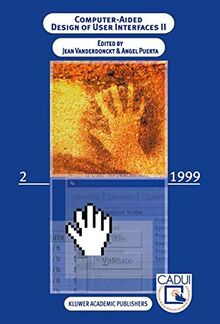
INTRODUCTION TO COMPUTER-AIDED DESIGN OF USER INTERFACES l 2 Jean Vanderdonckt and Angel Puerta ,3 Jlnstitut d'Administration et de Gestion - Universite catholique de Louvain Place des Doyens, 1 - B-1348 Louvain-la-Neuve (Belgium) vanderdonckt@gant,ucl. ac,be , vanderdoncktj@acm,org Web: http://www. arpuerta. com JKnowledge Systems Laboratory, Stanford University, MSOB x215 Stanford, CA 94305-5479, USA puena@camis. stanford. edu 3RedWhaie Corp. , 277 Town & Country Village Palo Alto, CA 94303, USA puerta@ redwhale. com Web: http://www. redwhale. com Computer-Aided Design of Vser Interfaces (CADUI) is hereby referred to as the particular area of Human-Computer Interaction (HCI) intended to provide software support for any activity involved in the development life cycle of an interactive application, Such activities namely include task analysis, contextual inquiry [l], requirements definition, user-centred design, application modelling, conceptual design, prototyping, programming, in stallation, test, evaluation, maintenance, Although very recently addressed (e. g. , [3]), the activity of re-designing an existing user interface (VI) for an interactive application and the activity of re-engineering a VI to rebuild its underlying models are also considered in CADVI. A fundamental aim of CADVI is not only to provide some software sup port to the above activities, but also to incorporate strong and solid meth odological aspects into the development, thus fostering abstraction reflection and leaving ad hoc development aside [5,7]. Incorporating such methodo logical aspects inevitably covers three related, sometimes intertwined, facets: models, method and tools.